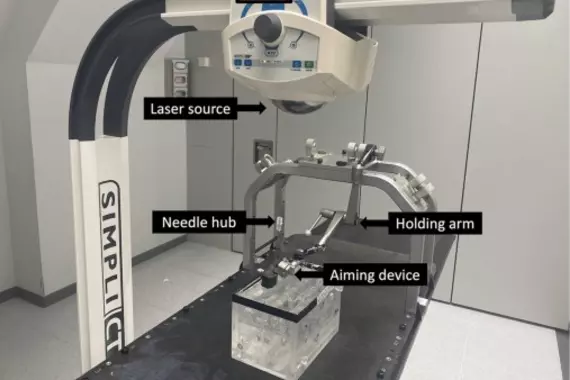Combining Aiming Device with Laser Guidance Significantly Improves Target Accuracy during CT Procedures
Posted on 01 May 2023
Laser guidance has been shown to enhance needle placement during percutaneous interventions, but it has certain limitations. Despite laser guidance, needles must still be inserted manually and constantly illuminated to prevent clinicians from losing their mark. If a needle isn't adequately supported, its path may deviate during verification scans, necessitating additional sequences and increasing radiation exposure. A new study suggests that an aiming device could offer a solution to this issue.
Researchers at Medical University Innsbruck (Innsbruck, Austria) discovered that using an aiming device in conjunction with laser guidance during interventional CT procedures can boost targeting accuracy. They tested the effectiveness of an Atlas aiming device and compared its accuracy by performing 600 CT-guided punctures with and without targeting support on a plexiglass phantom. Planning CT data sets with 1.25, 2.5, and 5 mm slice thicknesses were obtained to evaluate needle accuracy and the impact of device usage on procedural times. Euclidean (ED) and normal distances (ND) were calculated at the target point.

When using the aiming device, the mean ND at the target for the 1.25, 2.5, and 5 mm slice thicknesses were 1.76 mm, 2.09 mm, and 1.93 mm, respectively. In comparison, freehand insertion results were 2.55 mm, 2.7 mm, and 2.31 mm. The accuracy of both ED and ND was significantly improved with the device at a slice thickness of 1.25 mm and 2.5 mm. However, the device led to a slight increase in procedure times, from 24.8 minutes without it to 29.8 minutes with it. Aiming devices, which stabilize needles, could be particularly helpful in reaching superficial or bone lesions and may also be useful for targeting deep lesions, according to the researchers. The team highlighted that their findings "indicate a clear, statistically significant superiority" in accuracy when using an aiming device and added that it should be technically feasible for adoption along with laser guidance systems already in clinical use.
“Additional support could be provided by a rigid aiming device to maintain the needle's steady position within the laser beam. In addition, a needle holder already aligned at the target allows needle insertion at a higher velocity, which may enhance position accuracy and reduce tissue damage,” concluded the researchers.






 Guided Devices.jpg)







